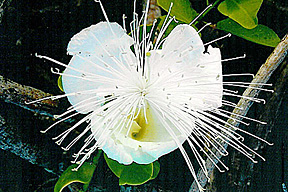|
In the Garden
|
Night bloomer reflects
moonlight
Caparis sandwichiana
Description: Maiapilo is a small sprawling shrub with soft, light green leaves, brittle stems and white flowers. The flowers are large for a native plant, about 2 to 4 inches wide and up to 4 inches tall, and are extremely fragrant. The flower looks like a cross between a white rose and a white 'ohi'a lehua flower.
![]()

Maiapilo is a night-blooming flower. For more information about this shrub and other native Hawaiian plants, go online at www.nativehawaiianplants.com.
Distribution: This rare endemic plant is found on the coast of all the main islands, including some of the offshore islets and some of the Northwestern Hawaiian Islands. The plant pictured here is one of the last known plants on Oahu's east side. There were two plants growing side by side at Makapuu, but both fell victim to recent construction of a walking path.
Cultural uses: This plant is a relative of capers. There are no known cultural uses for it.
Landscape uses and care: This is an excellent plant for a xeriscape garden because it requires very little water once established. It is also an ideal plant for a "moon garden" because its big white flowers will shine and shimmer in the moonlight. Be on the watch for white cabbage butterflies and their caterpillars, which occasionally munch on plant leaves. Full sun and well-drained soil are best for maiapilo, and letting the ground dry out in between watering is also a good idea.
Also: With this plant's increasing rarity, due to overdevelopment of its coastal habitat, the low numbers of maiapilo could also reduce the population of the native moth for lack of food and sustainable habitat. It is important to protect all native Hawaiian life because, whether it is directly or indirectly, all life is intertwined.
![]()
E-mail to Features Desk
[News] [Business] [Features] [Sports] [Editorial] [Do It Electric!]
[Classified Ads] [Search] [Subscribe] [Info] [Letter to Editor]
[Feedback]
